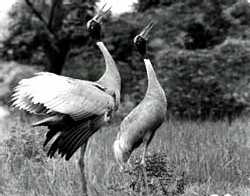Bird s eye view
 the title of the book might convey the impression that it is limited to birds and their habitats. But it actually gives an exhaustive overview of the environment, with birds as the parameter for judging the state of the natural world.
the title of the book might convey the impression that it is limited to birds and their habitats. But it actually gives an exhaustive overview of the environment, with birds as the parameter for judging the state of the natural world.
A rare degree of knowl edge and experience is shared in this volume by Prakash Gole, a pioneering ornithologist of India. Backed by extensive field experience, not only has he discussed various environmental and ornithological issues but has also written about means of tackling problems concerning the same. In this context, the very first chapter describes the debate between ecologists and town planners under the aegis of the Mahabaleshwar-Panchgani Regional Planning Board set up in 1966, and the final solutions (ensuring that the ecological balance of the plateau is not damaged) put forth.
The book is a thought-provoking study and can be very useful for researchers and policy-makers. The dismal story of the cessation of migration of the black-necked cranes to the Sangti and Chukhow valleys in Arunachal Pradesh bears testimony to the detriment brought about on these winged creatures by the so-called concept of human development. The excessive use of dynamite in road construction in the region has been identified as one of the main reasons why the arrival of these winter guests is now being written off as an event of the past.
The author cautions that as unplanned development continues to take a heavy toll on our varied avifauna, the demand for the protection of birds is going to increase. But it would be difficult to translate this objective into actual practice if conservation efforts are not backed by adequate scientific investigation and research. It is to highlight this cardinal point that the longest chapter of the book is devoted to the management of bird sanctuaries. The book serves well by exposing some mythical beliefs like birds being grain-eaters and therefore being inimical to farmers.
The book takes one on journeys to far-flung regions of Arunachal Pradesh, Bhutan, Tibet and Ladakh, giving a vivid account of the roosting, feeding, nesting and migrating habits of the sarus, black-necked cranes and Anser indicus (rajhans). A very delicate balance governs the composition of birds in a given habitat, as illustrated by the present state of the Mula-Mutha river in Pune. This river which was once graced by the colourful brahminy kite and bronze-winged jacanas, is now frequented by more scavenging birds like the black-winged stilts and gull-billed terns because of the alarming quantity of city sewage now flowing into it. The maintenance of wetlands, open green areas and a positive attitude on the part of humans towards our avian citizens are the prime factors that will decide the future of our already endangered avifauna.
Occasionally, the reader might lose interest while reading the book as some of the chapters have been given too much of a statistical orientation. But it is certainly a germane work and if pursued further, should help a great deal in retaining India's natural wealth.
Related Content
- Order of the Supreme Court regarding protection of Great Indian Bustard (GIB) and Lesser Florican, 21/03/2024
- State of the world’s migratory species
- Living planet report 2022
- Mainstreaming biodiversity in forestry
- The Wildlife Protection (Amendment) Bill,2021
- IPBES workshop on biodiversity and pandemics: workshop report
